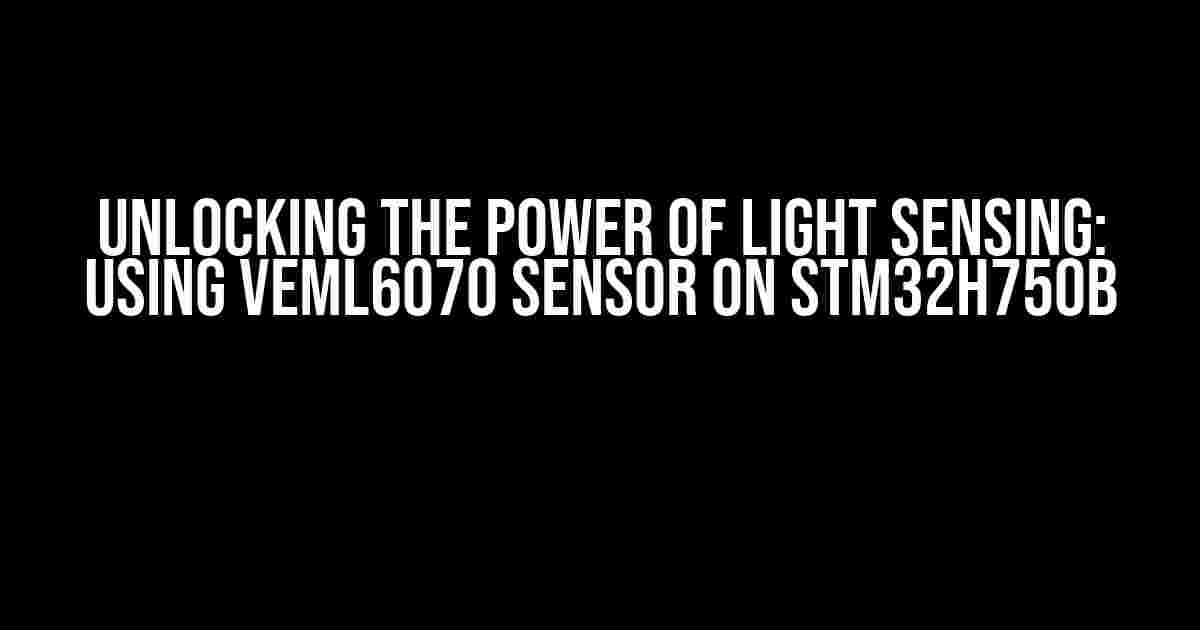Introduction
Light sensing has become an integral part of modern technology, from adjusting display brightness to monitoring environmental conditions. The VEML6070 sensor is a popular choice for measuring UV radiation, and when paired with the powerful STM32H750B microcontroller, the possibilities are endless. In this article, we’ll take you on a step-by-step journey to integrate the VEML6070 sensor with the STM32H750B, unlocking a world of innovative applications.
Hardware Requirements
- STM32H750B Evaluation Board
- VEML6070 UV Light Sensor Breakout Board
- Breadboard and Jumper Wires
- USB Cable for Programming
Software Requirements
- STM32CubeMX Software (for configuring the microcontroller)
- Keil µVision IDE (for programming the microcontroller)
- UART Terminal Software (for monitoring sensor data)
Understanding the VEML6070 Sensor
The VEML6070 is a high-performance UV sensor that measures UV radiation in the UVA (365 nm) and UVB (295 nm) ranges. This sensor is particularly useful for applications such as:
- Sunlight monitoring for solar panels
- UV index measurement for weather monitoring
- Light therapy for medical applications
VEML6070 Pinout
| Pin | Description |
|---|---|
| VCC | Power Supply (3.3V) |
| GND | Ground |
| SCL | Serial Clock (I2C) |
| SDA | Serial Data (I2C) |
| INT | Interrupt Pin |
Configuring the STM32H750B
To begin, we’ll configure the STM32H750B using STM32CubeMX software. This will involve enabling the I2C peripheral and configuring the pinout for communication with the VEML6070 sensor.
1. Open STM32CubeMX and create a new project for the STM32H750B. 2. In the Pinout tab, enable the I2C1 peripheral and configure the pins as follows: - PB6: SCL - PB7: SDA 3. In the Clock Configuration tab, set the I2C clock speed to 400 kHz. 4. Generate the code and save it as a Keil µVision project.
Programming the STM32H750B
Now that we have our project set up, let’s write the code to communicate with the VEML6070 sensor using I2C.
#include "stm32h7xx_hal.h"
#define VEML6070_ADDRESS 0x38
int main(void) {
HAL_Init();
__HAL_RCC_I2C1_CLK_ENABLED();
I2C_HandleTypeDef hi2c1;
hi2c1.Instance = I2C1;
hi2c1.Init.ClockSpeed = 400000;
hi2c1.Init.DutyCycle = I2C_DUTYCYCLE_2;
HAL_I2C_Init(&hi2c1);
uint8_t data[2];
data[0] = 0x00; // Command to read UV data
while (1) {
HAL_I2C_Master_Transmit(&hi2c1, VEML6070_ADDRESS, data, 1, 100);
HAL_Delay(10);
HAL_I2C_Master_Receive(&hi2c1, VEML6070_ADDRESS, data, 2, 100);
printf("UV Index: %d\n", data[1]);
HAL_Delay(1000);
}
}
How it Works
In this code, we first initialize the I2C peripheral and configure the clock speed. We then send a command to the VEML6070 sensor to read the UV data, which is stored in the `data` array. The sensor responds with two bytes of data, where the first byte represents the UV index. We print this value to the UART terminal using `printf`.
Monitoring Sensor Data
Using a UART terminal software, connect to the STM32H750B’s serial port and configure the baud rate to 115200. You should now see the UV index values printed to the terminal, updating every second.
UV Index: 23 UV Index: 24 UV Index: 25 ...
Tips and Tricks
- When working with I2C, ensure that the SCL and SDA lines are properly connected and that the pull-up resistors are enabled.
- Use a level shifter if the VEML6070 sensor requires a different voltage level than the STM32H750B.
- Calibrate the VEML6070 sensor according to the datasheet for accurate UV index measurements.
Conclusion
In this article, we successfully integrated the VEML6070 sensor with the STM32H750B microcontroller, unlocking the power of light sensing for innovative applications. By following these steps and tips, you’ll be well on your way to creating projects that harness the power of UV radiation.
Remember to explore the VEML6070 sensor’s full potential by reading the datasheet and experimenting with different commands and settings. Happy building!
Copyright 2023 [Your Name]
Frequently Asked Questions
Get ready to illuminate your project with the VEML6070 sensor on STM32H750B! Here are some frequently asked questions to help you get started.
What is the VEML6070 sensor, and how does it work with STM32H750B?
The VEML6070 is a high-accuracy, low-power UV sensor that measures ultraviolet radiation levels. When paired with the STM32H750B microcontroller, it can provide precise UV index readings, enabling applications like wearable devices, smart home systems, and industrial monitoring. The VEML6070 communicates with the STM32H750B via the I2C interface, making it easy to integrate into your project.
What are the key features of the VEML6070 sensor that make it suitable for use with STM32H750B?
The VEML6070 boasts several features that make it an excellent choice for use with STM32H750B: high accuracy (±5% UV index), low power consumption (< 100 μA), and a wide operating temperature range (-40°C to 85°C). Additionally, it has a built-in ADC and I2C interface, making it easy to interface with the STM32H750B.
How do I connect the VEML6070 sensor to the STM32H750B microcontroller?
To connect the VEML6070 sensor to the STM32H750B, follow these steps: connect VCC to the STM32H750B’s 3.3V power supply, GND to the STM32H750B’s ground, SCL to the STM32H750B’s I2C clock pin (e.g., PB6), and SDA to the STM32H750B’s I2C data pin (e.g., PB7). Make sure to add pull-up resistors to the SCL and SDA lines.
What libraries or software frameworks do I need to use the VEML6070 sensor with STM32H750B?
To use the VEML6070 sensor with STM32H750B, you can utilize the STM32CubeH7 library, which provides a comprehensive set of APIs and drivers for the STM32H750B. Additionally, you can use third-party libraries like the VEML6070 Arduino library or the STM32 I2C library to simplify the development process.
What are some potential applications of using the VEML6070 sensor with STM32H750B?
The VEML6070 sensor paired with the STM32H750B enables a wide range of applications, such as wearable devices that track UV exposure, smart home systems that monitor indoor UV levels, and industrial monitoring systems that detect UV radiation in manufacturing environments. You can also use it in IoT projects, like environmental monitoring stations or agricultural monitoring systems.

